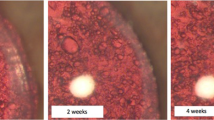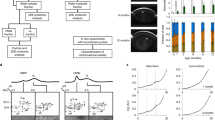Abstract
CATARACT (opacity) of the lens inevitably develops in young rats fed xylose or galactose1, or in young diabetic rats if the blood glucose is maintained at a level above 2.5 mgm./ml. blood2. These three forms of cataract which resemble each other closely in clinical and histological appearance, are known as ‘sugar’ cataracts because in all cases there is a raised level of monosaccharides in the blood. The early metabolic changes within the lens, which lead to gradual loss of transparency, are unknown. It was decided to examine the carbohydrates and their derivatives in normal and cataractous lenses to see if changes occurred in ‘sugar’ cataract, and if so whether there was any similarity in this respect between the three forms of cataract.
This is a preview of subscription content, access via your institution
Access options
Subscribe to this journal
Receive 51 print issues and online access
$199.00 per year
only $3.90 per issue
Buy this article
- Purchase on Springer Link
- Instant access to full article PDF
Prices may be subject to local taxes which are calculated during checkout
Similar content being viewed by others
References
Sterling, R. E., and Day, P. L., Proc. Soc. Exp. Biol., 78, 431 (1951).
Patterson, J. W., Amer. J. Physiol., 165, 61 (1951).
Darby, W. J., and Day, P. L., Proc. Soc. Exp. Biol., 41, 507 (1939).
Klebanoff, S. J., and Greenbaum, A. L., J. Endocrinol., 11, 314 (1954).
van Heyningen, R., Biochem. J. (in the press).
Hers, H. G., “Le Métabolisme de Fructose” (Editions Arsica, Brussels, 1957).
McCorkindale, J., Edson, N. L., Biochem. J., 57, 518 (1954).
Author information
Authors and Affiliations
Rights and permissions
About this article
Cite this article
VAN HEYNINGEN, R. Formation of Polyols by the Lens of the Rat with ‘Sugar’ Cataract. Nature 184, 194–195 (1959). https://doi.org/10.1038/184194b0
Issue Date:
DOI: https://doi.org/10.1038/184194b0
This article is cited by
-
The aldose reductase inhibitor epalrestat exerts nephritic protection on diabetic nephropathy in db/db mice through metabolic modulation
Acta Pharmacologica Sinica (2019)
-
Characterization of WY 14,643 and its Complex with Aldose Reductase
Scientific Reports (2016)
-
Effects of two antioxidants; α-lipoic acid and fisetin against diabetic cataract in mice
International Ophthalmology (2015)
-
Antihyperglycaemic and aldose reductase inhibitory potential of Acacia catechu hard wood and Tectona grandis leaves
Medicinal Chemistry Research (2011)
-
Glucose neurotoxicity
Nature Reviews Neuroscience (2008)
Comments
By submitting a comment you agree to abide by our Terms and Community Guidelines. If you find something abusive or that does not comply with our terms or guidelines please flag it as inappropriate.



